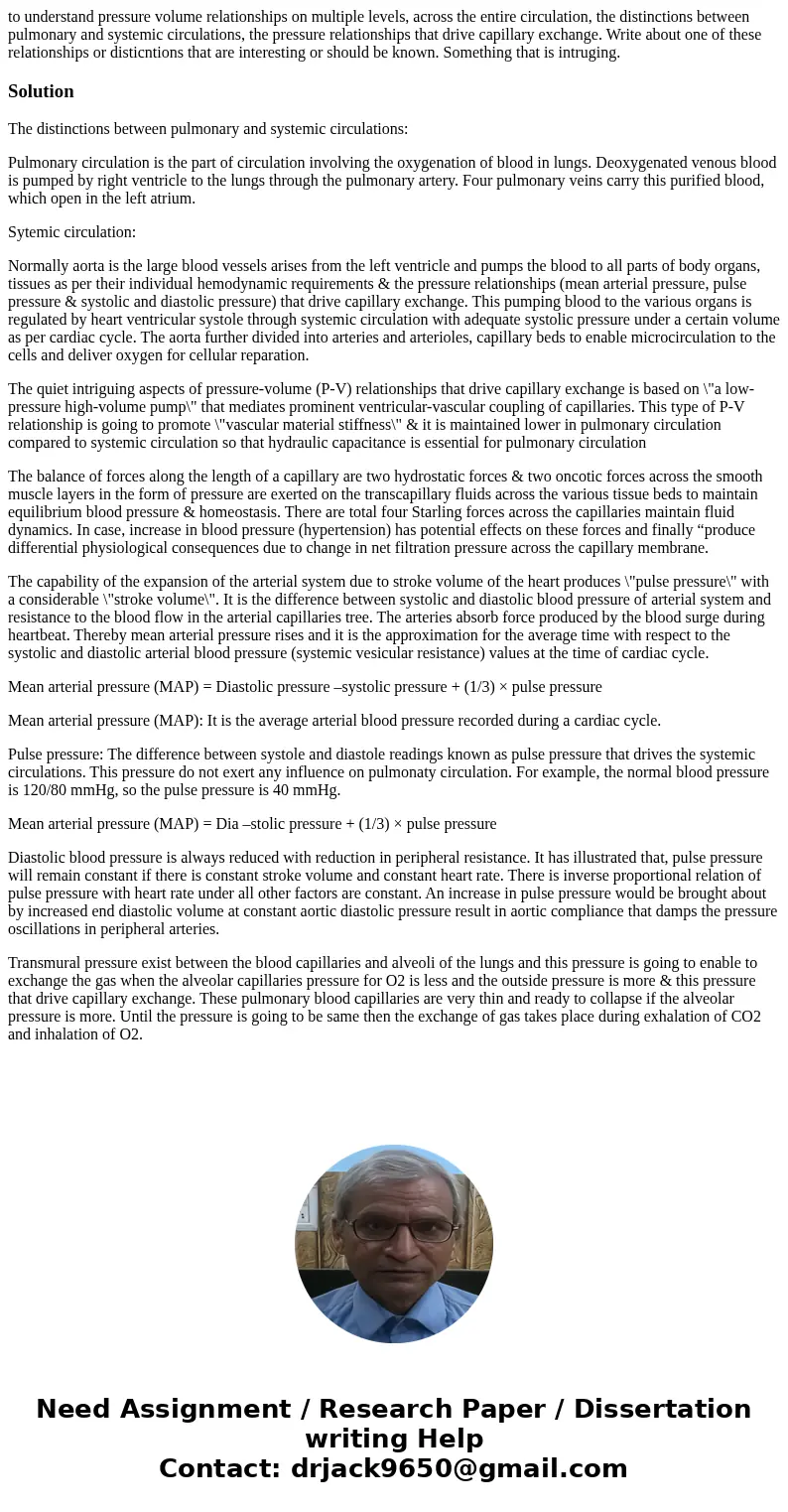to understand pressure volume relationships on multiple leve
to understand pressure volume relationships on multiple levels, across the entire circulation, the distinctions between pulmonary and systemic circulations, the pressure relationships that drive capillary exchange. Write about one of these relationships or disticntions that are interesting or should be known. Something that is intruging.
Solution
The distinctions between pulmonary and systemic circulations:
Pulmonary circulation is the part of circulation involving the oxygenation of blood in lungs. Deoxygenated venous blood is pumped by right ventricle to the lungs through the pulmonary artery. Four pulmonary veins carry this purified blood, which open in the left atrium.
Sytemic circulation:
Normally aorta is the large blood vessels arises from the left ventricle and pumps the blood to all parts of body organs, tissues as per their individual hemodynamic requirements & the pressure relationships (mean arterial pressure, pulse pressure & systolic and diastolic pressure) that drive capillary exchange. This pumping blood to the various organs is regulated by heart ventricular systole through systemic circulation with adequate systolic pressure under a certain volume as per cardiac cycle. The aorta further divided into arteries and arterioles, capillary beds to enable microcirculation to the cells and deliver oxygen for cellular reparation.
The quiet intriguing aspects of pressure-volume (P-V) relationships that drive capillary exchange is based on \"a low-pressure high-volume pump\" that mediates prominent ventricular-vascular coupling of capillaries. This type of P-V relationship is going to promote \"vascular material stiffness\" & it is maintained lower in pulmonary circulation compared to systemic circulation so that hydraulic capacitance is essential for pulmonary circulation
The balance of forces along the length of a capillary are two hydrostatic forces & two oncotic forces across the smooth muscle layers in the form of pressure are exerted on the transcapillary fluids across the various tissue beds to maintain equilibrium blood pressure & homeostasis. There are total four Starling forces across the capillaries maintain fluid dynamics. In case, increase in blood pressure (hypertension) has potential effects on these forces and finally “produce differential physiological consequences due to change in net filtration pressure across the capillary membrane.
The capability of the expansion of the arterial system due to stroke volume of the heart produces \"pulse pressure\" with a considerable \"stroke volume\". It is the difference between systolic and diastolic blood pressure of arterial system and resistance to the blood flow in the arterial capillaries tree. The arteries absorb force produced by the blood surge during heartbeat. Thereby mean arterial pressure rises and it is the approximation for the average time with respect to the systolic and diastolic arterial blood pressure (systemic vesicular resistance) values at the time of cardiac cycle.
Mean arterial pressure (MAP) = Diastolic pressure –systolic pressure + (1/3) × pulse pressure
Mean arterial pressure (MAP): It is the average arterial blood pressure recorded during a cardiac cycle.
Pulse pressure: The difference between systole and diastole readings known as pulse pressure that drives the systemic circulations. This pressure do not exert any influence on pulmonaty circulation. For example, the normal blood pressure is 120/80 mmHg, so the pulse pressure is 40 mmHg.
Mean arterial pressure (MAP) = Dia –stolic pressure + (1/3) × pulse pressure
Diastolic blood pressure is always reduced with reduction in peripheral resistance. It has illustrated that, pulse pressure will remain constant if there is constant stroke volume and constant heart rate. There is inverse proportional relation of pulse pressure with heart rate under all other factors are constant. An increase in pulse pressure would be brought about by increased end diastolic volume at constant aortic diastolic pressure result in aortic compliance that damps the pressure oscillations in peripheral arteries.
Transmural pressure exist between the blood capillaries and alveoli of the lungs and this pressure is going to enable to exchange the gas when the alveolar capillaries pressure for O2 is less and the outside pressure is more & this pressure that drive capillary exchange. These pulmonary blood capillaries are very thin and ready to collapse if the alveolar pressure is more. Until the pressure is going to be same then the exchange of gas takes place during exhalation of CO2 and inhalation of O2.

 Homework Sourse
Homework Sourse